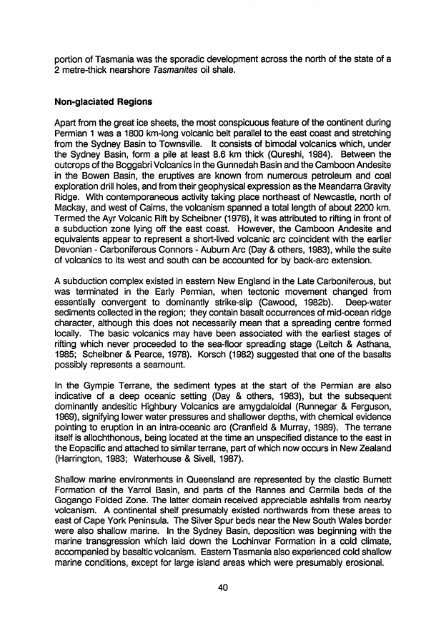II II II II II - Geoscience Australia
II II II II II - Geoscience Australia
II II II II II - Geoscience Australia
You also want an ePaper? Increase the reach of your titles
YUMPU automatically turns print PDFs into web optimized ePapers that Google loves.
portion of Tasmania was the sporadic development across the north of the state of a<br />
2 metre-thick nearshore Tasmanites oil shale.<br />
Non-glaciated Regions<br />
Apart from the great ice sheets, the most conspicuous feature of the continent during<br />
Permian 1 was a 1800 km-long volcanic belt parallel to the east coast and stretching<br />
from the Sydney Basin to Townsville. It consists of bimodal volcanics which, under<br />
the Sydney Basin, form a pile at least 8.6 km thick (Qureshi, 1984). Between the<br />
outcrops of the Boggabri Volcanics in the Gunnedah Basin and the Camboon Andesite<br />
in the Bowen Basin, the eruptives are known from numerous petroleum and coal<br />
exploration drill holes, and from their geophysical expression as the Meandarra Gravity<br />
Ridge. With contemporaneous activity taking place northeast of Newcastle, north of<br />
Mackay, and west of Cairns, the volcanism spanned a total length of about 2200 km.<br />
Termed the Ayr Volcanic Rift by Scheibner (1976), it was attributed to rifting in front of<br />
a subduction zone lying off the east coast. However, the Cannboon Andesite and<br />
equivalents appear to represent a short-lived volcanic arc coincident with the earlier<br />
Devonian - Carboniferous Connors - Auburn Arc (Day & others, 1983), while the suite<br />
of volcanics to its west and south can be accounted for by back-arc extension.<br />
A subduction complex existed in eastern New England in the Late Carboniferous, but<br />
was terminated in the Early Permian, when tectonic movement changed from<br />
essentially convergent to dominantly strike-slip (Cawood, 1982b). Deep-water<br />
sediments collected in the region; they contain basalt occurrences of mid-ocean ridge<br />
character, although this does not necessarily mean that a spreading centre formed<br />
locally. The basic volcanics may have been associated with the earliest stages of<br />
rifting which never proceeded to the sea-floor spreading stage (Leitch & Asthana,<br />
1985; Scheibner & Pearce, 1978). Korsch (1982) suggested that one of the basalts<br />
possibly represents a seannount.<br />
In the Gympie Terrane, the sediment types at the start of the Permian are also<br />
indicative of a deep oceanic setting (Day & others, 1983), but the subsequent<br />
dominantly andesitic Highbury Volcanics are amygdaloidal (Runnegar & Ferguson,<br />
1969), signifying lower water pressures and shallower depths, with chemical evidence<br />
pointing to eruption in an intra-oceanic arc (Cranfield & Murray, 1989). The terrane<br />
itself is allochthonous, being located at the time an unspecified distance to the east in<br />
the Eopacific and attached to similar terrane, part of which now occurs in New Zealand<br />
(Harrington, 1983; Waterhouse & Sive<strong>II</strong>, 1987).<br />
Shallow marine environments in Queensland are represented by the clastic Burnett<br />
Formation of the Yarrol Basin, and parts of the Rannes and Carmila beds of the<br />
Gogango Folded Zone. The latter domain received appreciable ashfalls from nearby<br />
volcanism. A continental shelf presumably existed northwards from these areas to<br />
east of Cape York Peninsula. The Silver Spur beds near the New South Wales border<br />
were also shallow marine. In the Sydney Basin, deposition was beginning with the<br />
marine transgression which laid down the Lochinvar Formation in a cold climate,<br />
accompanied by basaltic volcanism. Eastern Tasmania also experienced cold shallow<br />
marine conditions, except for large island areas which were presumably erosional.<br />
40

















